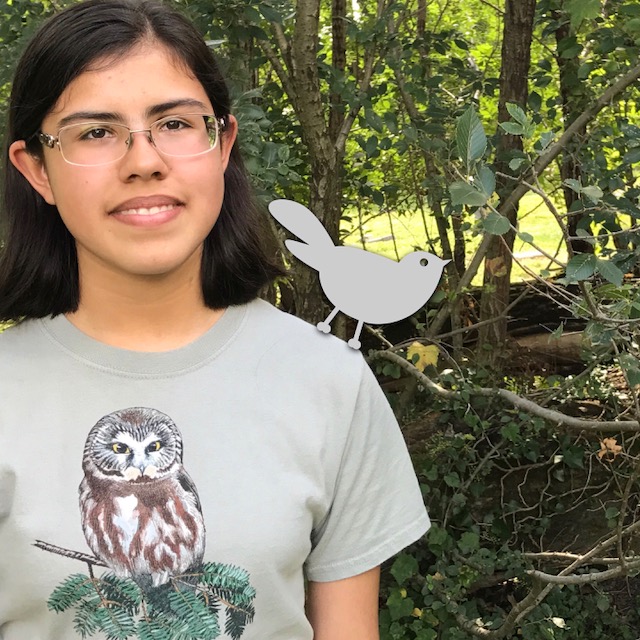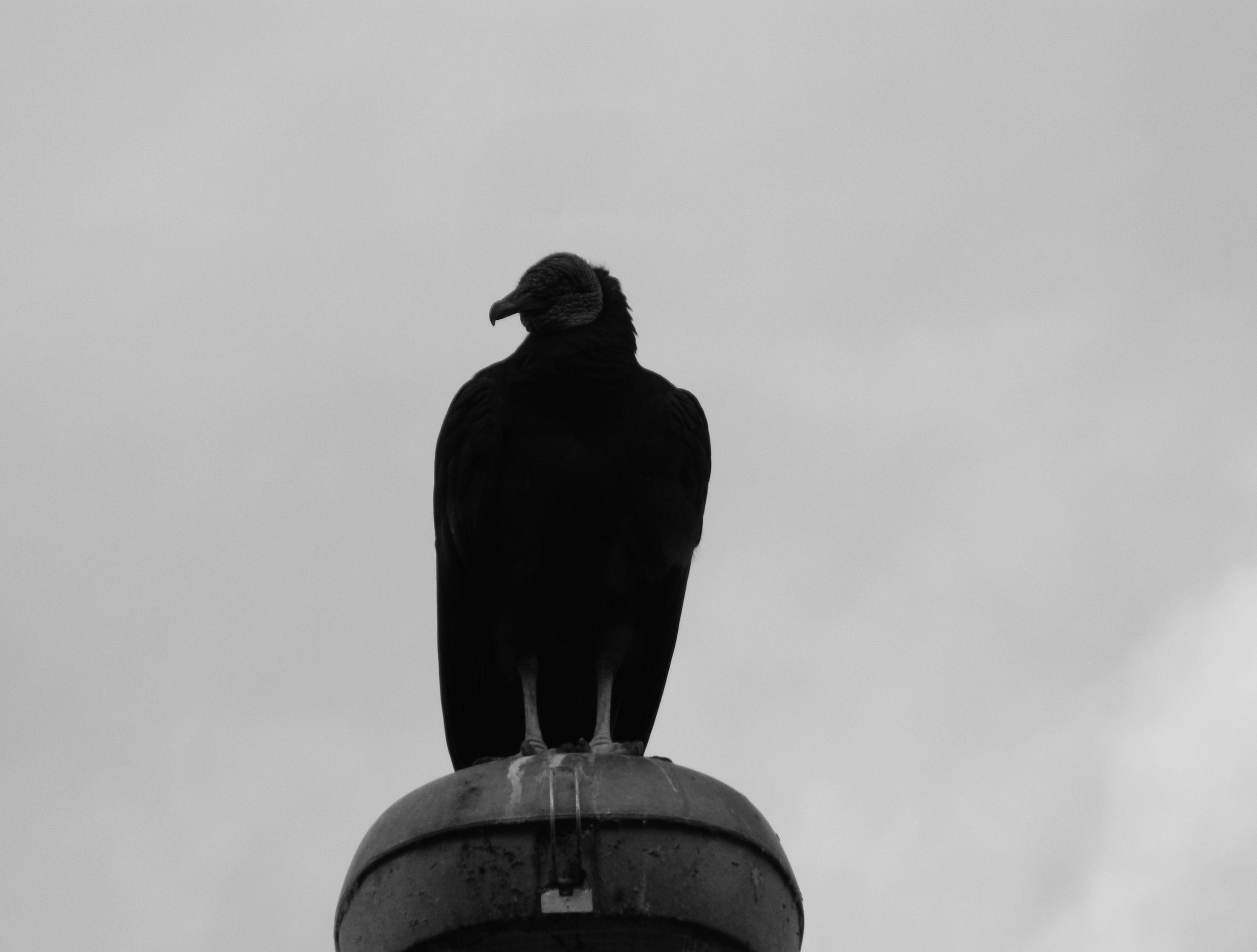I have loved birds since I was five years old! I am now fourteen and an intern for the Woodlands.
My talking parakeet gave me the nickname “Toribird”. Coincidentally, ‘Tori’ means ‘bird’ in Japanese!
In addition to The Woodlands, I also volunteer at a bird-banding station. I found a rare Black-headed Gull at John Heinz NWR, own a parakeet, and have participated in birding competitions. However, I'm not a total bird-brain. I am a nature photographer, pianist, and beginner singer. I enjoy writing stories that combine birds and music - my two passions.
Some notes on seasonal birding at the Woodlands:
Spring: Watch for migrating warblers, thrushes, and other songbirds. Swallows will arrive.
Summer: A rather dull time to bird. Look for breeding songbirds, and hummingbirds.
Fall: Look up! Migrating hawks, warblers, and nighthawks make Fall a fun season for birding.
Winter: Small songbirds such as sparrows and kinglets are fun to see. It is easy to see birds since the trees are leafless.
Sept. 27, 2017 Northern Rough-winged Swallows are plentiful at the Woodlands! However, they will soon migrate south, so catch them while you can. It is fun to watch these acrobats zip through the air as they chase insects.
The swallows are similar to the Chimney Swift, but swifts are gray, have shorter tails, and generally fly higher. Swifts will also soon fly south. But, when the acrobatic insectivores are gone, it will be time to watch for ducks, kinglets, and sparrows.
Northern Rough-winged Swallow photo by Toribird
Oct. 4, 2017 Hawks are awe-inspiring creatures. When they soar, they appear to be made of sun and wind. The great news is that hawks are easily seen at the Woodlands! The Woodlands are home to two hawk species: the Red-tailed Hawk and the Cooper's Hawk. The Cooper’s is seen in the forested area near the VA, and the Red-tail is seen in more open areas, generally near the house.
So how do you tell them apart? See the guide below.
Red-tailed Hawk: Overall chunky build. White belly, dark brown back, and rust-red tail. Band across the belly made of brown spots.
Cooper's Hawk: Overall slender build. Gray back and orange-tan belly. Thin black-and-white stripes on tail.
Oct. 11, 2017 If I say CROWS, what comes to mind? Do you think of spooky Halloween decorations, or a swarm of black birds, or a crow picking at bones?
Though crows have a bad, scary reputation in our culture, they are actually fascinating birds! Crows, magpies, and jays make up the Corvid family. Corvids are some of the smartest birds, capable of making tools, solving multi-step puzzles, and recognizing individual faces!
The American Crow is common in Philadelphia, and can certainly be seen at the Woodlands!
Oct. 18, 2017 If I had to guess, I'd say you didn't like vultures. You might even be afraid of them. However, they are interesting, useful, lovable birds.
Contrary to some myths, vultures do not predict death. Since they eat animals that are already dead, they almost never kill. And if they did not clean up carrion, there would be dead, rotting animals everywhere!
Also, though their heads are rather ugly, vultures' plumage is sleek and elegant. The Black Vulture is especially striking with its all-black body and silvery-white wingtips. Wildlife rehabbers and zookeepers have even described vultures as sweet and shy. It's no wonder vultures are my favorite birds!
Black Vulture photo by Toribird
Nov. 1, 2017 As the seasons change, some birds migrate south and others arrive. One of these new arrivals is the Yellow-rumped Warbler. These birds are a bit smaller than sparrows. They are overall brown with darker stripes and yellow patches at the base their of tail (rump; hence their name), head, and flanks. You will likely see them in a Juniper (evergreen) tree, eating the berries. These adorable birds are common, and can make birding even more fun!
Nov. 8, 2017 Have you ever heard the term 'Invasive Species'? If you're not familiar with this term, an invasive species is an animal, plant, or other organism that has been introduced to a part of the world where it did not originally occur.
There are many invasive birds in the United States. Three of the most common are Rock Doves (pigeons), House Sparrows, and European Starlings. Due to that fact that invasive birds are typically quite common, they are a good group for beginner birders to learn.
Unfortunately, since invasive species are adaptable and numerous, they often out-compete native birds. For example, European Starlings are pushing Purple Martins, a bird native to the US, out of the martins' former nest sites.
European Starling photo by Toribird
Nov. 15, 2017 Tap. Tap-tap. Tap-tap-ta-trrrrrr. A woodpecker drumming on a tree may be a familiar sound for you. Woodpeckers, as a group, are common, and adapt easily to living near humans. You may have even had a woodpecker drum an your house!
The woodpecker group consists of birds that have woodpecker, sapsucker, or flicker in their names. For example, the Downy Woodpecker, Yellow-bellied Sapsucker and Northern Flicker are all types of woodpeckers (and they all can be seen in Philly!).
The Red-bellied Woodpecker has one of the worst names in the history of ornithology! Not only does its "red belly" consist of only a faint pink tint, it also has a far more obvious red stripe going from its forehead to its nape. This can cause confusion with the similarly-named but overall different-looking Red-headed Woodpecker.
If you want to attract a woodpecker to your front yard, try putting up a suet feeder. Suet and the feeder can be found at most pet and grocery stores.
Nov. 30, 2017 As the nights get longer and the wind colder, people may think that winter is a bad time for birdwatching. It is true that some birds leave the Mid-atlantic to spend the season farther south. However, there are many that summer in northern places like Canada, and spend the winter right here in Philly!
Ducks, kinglets, and sparrows are among those that winter in this area. Also, birds like the Blue Jay, American Robin, and Red-tailed Hawk, along with various types of woodpeckers, can be seen year-round at The Woodlands.
Finally, since most trees have lost their leaves, it is much easier to find all these winter treasures!
Dec. 13, 2017 If you hear the word 'robin', you probably think of spring, blossoms, and April showers. However, contrary to popular belief, robins can be seen in Philly year-round!
Robins are a good bird for beginner birders to learn as they are distinctive, common, and, as mentioned above, can be seen all year. The distinctive markings of robins consist of a brick-red breast, gray back, yellow bill, and a broken white ring around the eye. See if you can spot these markings on the picture below!
The robin's full common name is American Robin, and its scientific name is Turdus migratorius.
American Robin photo by Toribird
Jan. 3rd, 2018 Though you might not think it, gulls are not seen only at the ocean. Ring-billed Gulls are a common year-round Philly resident. They are often seen on the Schuylkill and Delaware Rivers, lakes, and even shopping center parking lots! The Schuylkill River can be seen from the Woodlands, especially in winter. Try to spot a gull next time you visit!
To know what to look for, see the Ring-bill photo below.
Ring-billed Gull photo by Toribird
Jan. 24, 2018 With the Super Bowl coming up, everyone is talking about the Eagles. What better way to celebrate your team's victory than seeing a wild Bald Eagle? See the list below for good places to see our national bird and the mascot of Philly's football team.
The Woodlands: Bald Eagles have been seen at the Woodlands, though they are not as common as some other birds. Since they eat fish, they are usually seen flying over the Schuylkill River. They can be seen year-round.
Conowingo Dam (Maryland): There is a guarantee of seeing eagles here - if you go in the winter. The eagles love to hunt the stunned fish that come through the dam.
John Heinz at Tinicum: There is a resident, breeding pair of Bald Eagles here that can be seen year-round.
Feb. 28, 2018 Spring is just around the corner, and the weather seems to agree! For birding, this means spring migration! Two main groups of birds that pass through Philly is spring are warblers and shorebirds.
WARBLERS: small, often colorful insect-eating birds. Learning songs is helpful for identifying warblers high up in leafy trees. Yellow-rumped Warblers are winter birds for Philly, but most others pass though in spring and fall.
SHOREBIRDS: small to medium long-legged birds. They are often gray or brown, but cute despite dull color. They can be seen at the beach, on the shores of ponds, and on mudflats along rivers. Some stay year-round, but most migrate.
March 14, 2018 So you're watching a movie set in Alaska's wilderness. A Bald Eagle soars overhead, and you hear its majestic scream - "Kreeaa-kaa!"
Except... that's not really the sound that eagles make. The stereotypical hawk or eagle sound is the cry of the Red-tailed Hawk. This sound is used in place of the true eagle call for a good reason - Bald Eagles sound like hoarse chickens. To hear a recording of an eagle, click here: https://www.xeno-canto.org/explore?query=Bald+Eagle
April 11, 2018 Spring migration is a wonderful whirlwind of color, sound, and diversity. Many birds can only be seen in Philly during the spring and fall - they spend the summer farther north, like in Canada, and the winter farther south, in Florida or the Bahamas. One of these birds is the Blackpoll Warbler.
Blackpolls are known for their amazing flight from boreal forest in Alaska and Canada to South America. Some birds fly nonstop over the ocean! The blackpoll is not alone, however. Thrushes, orioles, and swifts also make incredible yearly journeys. Some shorebirds even make it to Argentina!
If you've been considering going on a birdwalk, now is the time! This display comes only once a year, so grab it while you can!
May 1, 2018 With the warmer weather comes a feathered cornucopia of color and activity! Let's take a closer look at the bird species and bird activity that we can expect to see in the next few weeks.
First of all, spring migration is nearing its peak! This means that many birds such as warblers, thrushes, and shorebirds are passing through Philly on their way to more northern regions. Also, birds like swallows and the Chimney Swift, to name a few, will return to breed right here.
Also, year-round residents like sparrows, finches, and woodpeckers are beginning to build nests. If you see a bird carrying grass, twine, or something similar, rest assured that it is busy constructing a safe home for its babies.
So head to the Woodlands, and see what springtime activity you can spot!
Tree Swallow photo by Toribird







